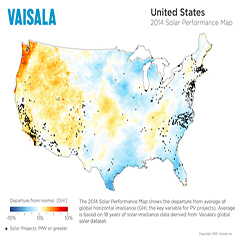Vaisala 2014 solar study reveals role of extreme weather patterns in growing East-West productivity divide
The East Coast of the U.S. experienced up to 5% lower than average levels of solar irradiance in 2014, negatively impacting overall performance of solar sites in the region. Concurrently, the West Coast enjoyed irradiance levels up to 10% higher than average, widening the productivity gap between projects in the country’s two areas of highest solar development.
This disparity is clearly seen in the 2014 Solar Performance Maps of the United States, released today by Vaisala, a global leader in environmental and industrial measurement.
While it is well-established that the solar resource of the East does not match that of the West, the Atlantic Coast has a large volume of operational capacity and it is therefore of critical importance for project operators in the region to understand the reasons behind below average energy output and whether it is due to malfunctioning equipment or weather variability.
Vaisala’s 2014 study illustrates the impact of short-term, month-to-month weather variations on performance at U.S. solar projects and places them into a long-term context. This reveals frequent and significant deviations from long-term average irradiance conditions and highlights the clear requirement to analyze the effect of solar resource variability on both over and underperformance.
From an annual perspective, this year’s weather patterns had an adverse effect on a large number of installations along the Atlantic Coast from Florida to Massachusetts, as well as Texas, while the bulk of projects in California and the Southwest saw an uptick in solar irradiance that may have increased overall 2014 production at many sites.
However, these annual variations only offer a high-level view of project performance. Vaisala also conducted a monthly analysis that gives a much more robust understanding of how specific weather conditions affected solar production throughout the year.
“The fact that California, for instance, had higher than average irradiance over the course of the year doesn’t tell the whole story,” said Gwendalyn Bender, Energy Assessment Product Manager at Vaisala. “We actually have many clients with projects in California coming to us with concerns about last year’s production numbers. As seen in our study, monthly low solar irradiance anomalies had a significant impact on generation, even in the West.”
The summer of 2014, for instance, was the coolest summer since 2009 and the ninth wettest summer on record within the continental U.S., with cloudy conditions leading to below average solar irradiance. This meant underwhelming solar performance in many regions where there are large numbers of operating projects, and negative media attention for solar projects recently put online – such as Ivanpah, Agua Caliente, Solana, and Topaz.
While the summer was disappointing, it was not the only or the most extreme anomaly of 2014. January, October, and December also saw atypical conditions where solar irradiance was more than 10% above or below average for much of the country*.
In terms of solar operations, routinely evaluating resource variability is critical for understanding in the short-term whether a project is performing as it should be, based on the available resource. This allows both distributed and utility-scale generators to effectively deploy maintenance and repair crews when problems, such as inverter issues or heavy snow on panels, lower production when resource data clearly show the sun was shining.
Vaisala’s anomaly analysis is also crucial for viewing recent performance from a long-term perspective. It allows operators to understand whether recent conditions (low or high irradiance, heavy snowfall, etc.) foretell what can be expected throughout a project’s lifetime or if it is out of the ordinary. For example, in Texas, where there is growing interest in solar and already a few operational projects, it is useful for developers and operators to understand that this past December’s solar irradiance was extraordinarily low compared to previous years due to unusually foggy conditions.
Vaisala is an expert in solar measurement, project assessment, and energy forecasting. It acquired 3TIER in 2013, a company that developed the first high-resolution, global solar dataset and has helped secure over US$5.5 billion in project financing worldwide. For more information on the range of services offered by Vaisala to the renewable energy sector, please visit www.vaisala.com/energy
*For further details please download Vaisala’s 2014 U.S. Solar Performance Maps, which include a report of key findings from the twelve-month climate analysis.
Vaisala Energy
Weather is the largest variable impacting electricity generation, transmission, and demand and it provides the fuel for renewable energy projects. Energy customers work with Vaisala to support efficient, reliable, and profitable electrical energy systems around the globe with a wide range of measurement, assessment, forecasting, and asset management products and services. Our real-time and historical lightning information ensures continuous energy generation, improved safety, and reduced costs in both energy production and transmission. Renewable energy developers and operators use Vaisala equipment and services to support the entire project lifecyle, from greenfield prospecting and due diligence to operational forecasting and plant optimization.
About Vaisala
Vaisala is a global leader in environmental and industrial measurement. Building on 79 years of experience, Vaisala contributes to a better quality of life by providing a comprehensive range of innovative observation and measurement products and services for chosen weather-related and industrial markets. Headquartered in Finland, Vaisala employs approximately 1600 professionals worldwide and is listed on the NASDAQ OMX Helsinki stock exchange. www.vaisala.com www.twitter.com/VaisalaGroup


























